THE CONSTRUCTION and THE TESTING PERIOD
THE CONSTRUCTION
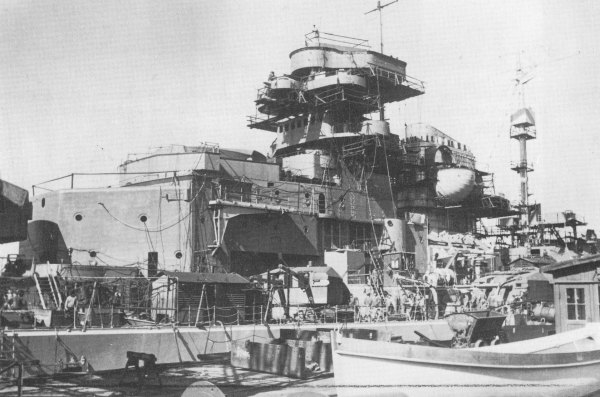
| "In June 1940, when I first saw the Bismarck, she was in the Hamburg yard of her builders, Blohm & Voss, awaiting completion and acceptance by the German Navy. Therefore, what I saw was a dusty steel giant, made fast to a wharf and littered with tools, welding equipment, and cables." Müllenheim-Rechberg |
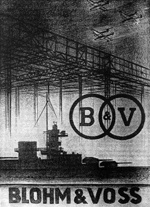 Blohm & Voss poster.
Blohm & Voss poster.
|
The keel of the
Bismarck was laid down on 1 July 1936 at the Blohm & Voss Shipyard facilities in Hamburg, construction number BV 509, on Slipway 9. By September 1938, the hull was already complete to the level of the upper deck. The launching ceremony took place at 1300 hours on Tuesday, 14 February 1939, and it was attended by more than 60,000 people, government officials, military personalities, and yard workers. It was a nice day highlighted by sparkling sunshine. The
Panzerschiff Admiral Scheer, the light cruiser
Nürnberg, the aviso
Grille, and three boats of the 4th Torpedo Flotilla had gathered in the harbour. Photographing and cameras was not permitted among guests, and only official agencies were allowed to take pictures. Adolf Hitler and his party arrived at the shipyard on board the yacht
Hamburg, and then the
Führer stepped up to the christening rostrum at the bow of the ship to deliver the pre-launch speech:
"Twenty years ago, the fleet met its destiny and demise in the seas during four years of valiant combat, and this still touches the heart of every German today… Six years after the National Socialist revolution, we are witnessing today the launching of the third and largest battleship of our new fleet. As the Führer of the German people and as chancellor of the Reich, I can give it no better name from our historical past than the name of the man who was a fearless knight in shining armor, the creator of that German Reich whose foresight has provided to us now with the means for the resurrection from bitter adversity and the wonderful expansion of the nation. German builders, engineers, and industrial workers have created the towering hull of this proud giant of the seas. May the German soldiers, and the officers who one day will have the honor to command this ship, always be worthy of the name it bears. May the spirit of the Iron Chancellor be with them, may it accompany them on their joyful journeys in times of peace, and may it also, in times of peril, guide them in the hours of their utmost call-to-duty. With these fervent wishes the German Nation salutes its new battleship Bismarck!”
The hull was then christened by Frau Dorothea von Loewenfeld, granddaughter of the German chancellor Otto von Bismarck, after whom the ship was named. Moments afterwards, at 1334, the last breaking chocks were freed up, the hydraulic jacks began to push, and the cheers of the tens of thousands almost drowned out the sound of the German national anthem (Deutschland über alles) which accompanied the Bismarck in her glide down the launching ramp as she entered the water for the fist time.
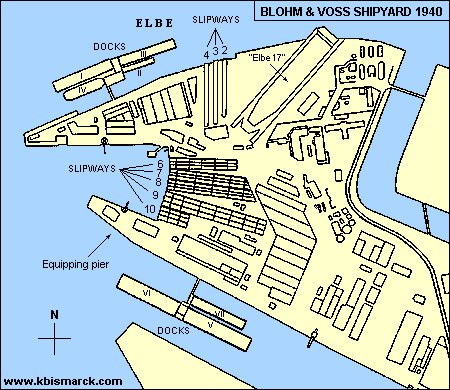 The Bismarck was the last capital ship launched at the Blohm & Voss shipyard. The first battleship of the new H-Class was laid down on 15 July 1939, but construction was suspended less than three months later on 10 October, and finally cancelled on August 1941. After that, all the yard resources were focused on the construction of U-boats.After the launching, the Bismarck was moored to the equipping pier where the boilers, turrets and all other parts of the superstructure began to be installed. The KC n/A plates of the armoured belt were attached to the hull’s sides. In addition, the original straight stem was replaced with a new "Atlantic" bow that offered better sea-keeping capabilities and a different arrangement for the anchors. The war started in September 1939, but despite this and the hard winter that followed, the construction work continued as scheduled.
The Bismarck was the last capital ship launched at the Blohm & Voss shipyard. The first battleship of the new H-Class was laid down on 15 July 1939, but construction was suspended less than three months later on 10 October, and finally cancelled on August 1941. After that, all the yard resources were focused on the construction of U-boats.After the launching, the Bismarck was moored to the equipping pier where the boilers, turrets and all other parts of the superstructure began to be installed. The KC n/A plates of the armoured belt were attached to the hull’s sides. In addition, the original straight stem was replaced with a new "Atlantic" bow that offered better sea-keeping capabilities and a different arrangement for the anchors. The war started in September 1939, but despite this and the hard winter that followed, the construction work continued as scheduled.
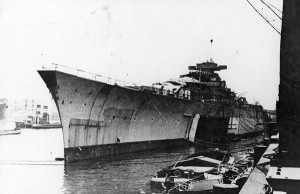
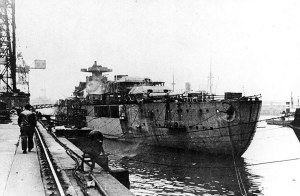 The Bismarck in Hamburg in December 1939.
In April 1940, the first members of the future crew began to assemble aboard, and with them the 46 year-old newly-appointed ship's commander, Captain Ernst Lindemann. The Bismarck was still completing, and these men started the first phase of training intended to get familiarised with the battleship's equipment such as the boilers, turbines, turrets etc. On 23 June, the Bismarck entered the floating dry dock No. V-VI where the three propellers and the MES (Mangnetischer Eigenschutz) magnetic self-protection system were installed. The keel was also repainted. The battleship got out of the dry dock on 14 July and then she was again moored to the pier. A few days later, on 21 July, the Bismarck underwent an inclining test (Krängungsversuch), and in the “empty ship as completed condition” at 42,500 tons, a metacentric height (GM) of 3,9 m was recorded. The crew, officially comprised of 103 officers and 1,962 non-commissioned officers and men, was still not complete, and new men came aboard gradually. Actually, they did not live aboard the Bismarck yet, and most of them were lodged at the barrack ships General Artigas andOceana.
The Bismarck in Hamburg in December 1939.
In April 1940, the first members of the future crew began to assemble aboard, and with them the 46 year-old newly-appointed ship's commander, Captain Ernst Lindemann. The Bismarck was still completing, and these men started the first phase of training intended to get familiarised with the battleship's equipment such as the boilers, turbines, turrets etc. On 23 June, the Bismarck entered the floating dry dock No. V-VI where the three propellers and the MES (Mangnetischer Eigenschutz) magnetic self-protection system were installed. The keel was also repainted. The battleship got out of the dry dock on 14 July and then she was again moored to the pier. A few days later, on 21 July, the Bismarck underwent an inclining test (Krängungsversuch), and in the “empty ship as completed condition” at 42,500 tons, a metacentric height (GM) of 3,9 m was recorded. The crew, officially comprised of 103 officers and 1,962 non-commissioned officers and men, was still not complete, and new men came aboard gradually. Actually, they did not live aboard the Bismarck yet, and most of them were lodged at the barrack ships General Artigas andOceana.

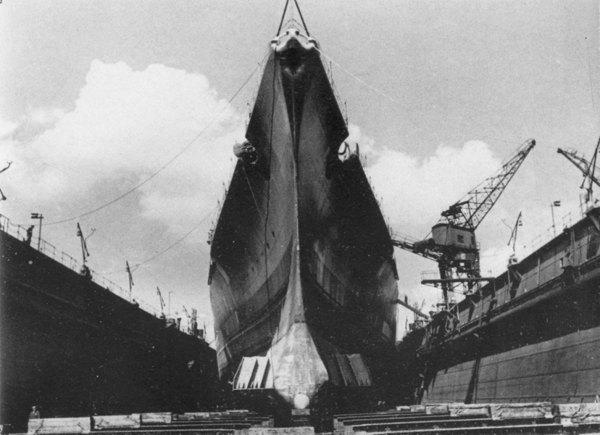 The Bismarck in Hamburg in June 1940 (left). Bismarck in dry dock June-July 1940 (right).
The Day of Commissioning.
The Bismarck in Hamburg in June 1940 (left). Bismarck in dry dock June-July 1940 (right).
The Day of Commissioning.
On Saturday, 24 August 1940, the ship was finally ready to be commissioned and enter in active service with the Kriegsmarine. It was a cloudy day, and the crew was formed on the upper deck waiting for Captain Lindemann to appear in order to begin the commissioning ceremony. Soon after, Lindemann approached the battleship on a white captain’s launch which carried the German battle flag. The Captain stepped aboard and proceeded to inspect the honour guard first, then the officers, and the rest of the crew thereafter. The Executive Officer (I.O.), Commander Hans Oels and Lieutenant von Müllenheim-Rechberg (at the time, adjudant to the commanding officer) escorted him. After inspecting the ship's company, Lindemann went to the afterdeck to say a few words. Standing behind him were two signal mates at the flagstaff, one of them, master signal mate Franz J. Scharhag carried the battle flag (Kriegsflagge) rolled up under his right arm. After the address, Lindemann gave the order to hoist the battle flag and the national anthem began playing. The battleship Bismarck was now in service and all the men were dismissed and ordered below decks.1)
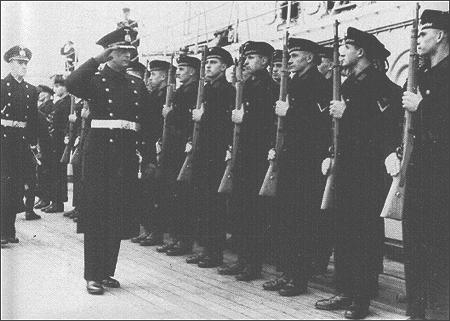 Captain Ernst Lindemann inspecting the honour guard on 24 August 1940.
Captain Ernst Lindemann inspecting the honour guard on 24 August 1940.
THE TESTING PERIOD
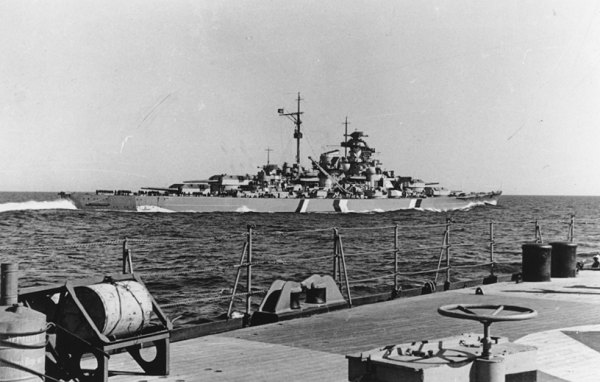 The Bismarck conducting sea trials in the Baltic as seen from the afterdeck of the cruiser Prinz Eugen in April 1941.
The Bismarck conducting sea trials in the Baltic as seen from the afterdeck of the cruiser Prinz Eugen in April 1941.
Immediately after the Bismarck was commissioned and the crew organised into divisions, full training began. This included guided tours through the battleship, anti-aircraft watch and combat training in the harbour to get familiar with the ship and to work together as a team. Air alarms, damage control and battle stations were the most common drills.
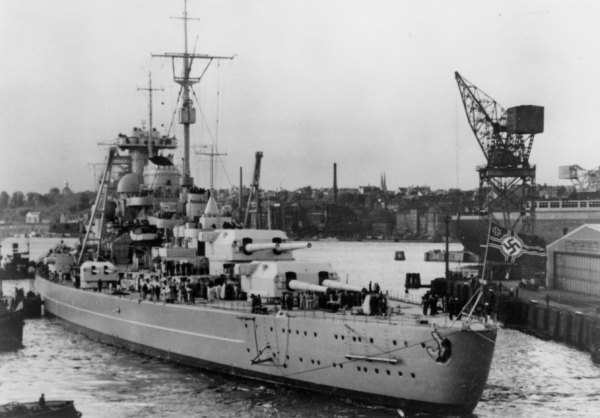 The Bismarck leaving the Blohm & Voss shipyard in Hamburg on 15 September 1940.
The Bismarck leaving the Blohm & Voss shipyard in Hamburg on 15 September 1940.
|
On 15 September 1940, the Bismarckdeparted Hamburg for the first time to conduct her sea trials in the Baltic Sea with her base in Gotenhafen (today Gdynia). The Baltic was a very secure place to conduct sea trials and exercises, and it was utilized by practically every single unit in the Kriegsmarine during the war. Its only entrance through the Skagerrak and the Kattegat was very well guarded and strongly protected by minefields. At 1658, while steaming north down the Elbe River, the Bismarck collided with the bow tug Atlantik, but fortunately neither vessel was damaged, and at 1902 the battleship anchored in Brunsbüttel Roads in order to enter the Kiel Canal the next day. During the night of 15/16 September, while anchored there, British aircraft appeared in the sky and the anti-aircraft battery of the Bismarck engaged them at once. More than 300 projectiles were fired byBismarck, but no observable hits were scored on enemy aircraft. On 16 September, the Bismarck entered the Kiel Canal. The Kiel Canal, inaugurated in 1895, runs for 98 kilometres through Schleswig-Holstein (from Brunsbüttel to Kiel-Holtenau), and links the North Sea with the Baltic, thus avoiding a longer voyage around the Jutland Peninsula. The Bismarck passed through the canal assisted by tugboats. At 1448 on 17 September, the ship entered the Kiel-Holtenau sluice, got out of the Kiel Canal, and then came alongside in Scheerhafen, Kiel, on 17 September, where she stayed for the next week calibrating the batteries and embarking supplies. After four more days of having made fast to Buoy A 12, the Bismarckdeparted Kiel on 28 September, escorted by the mine clearance vessel 13 (Sperrbrecher 13) up to Rügen Island, and then arrived at Gotenhafen alone on the same day.

The Bismarck en route to Brunsbüttel roads on 15 September 1940. | 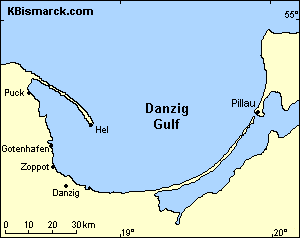 |
Once in Gotenhafen, and during the following two months, the Bismarck conducted several navigation, consumption, and speed trials in the Gulf of Danzig. Measured mile runs (Meilenfahrten) were performed off Neukrug near Pillau (today Baltiysk) in water depths of 65 metres. On 23 October the ship was finally ready to sail at full speed. The propulsion plant originally designed to reach 138,000 hp and 29 knots actually obtained 150,170 hp and 30.1 knots. This made of the Bismarck one of the fastest battleships in the world, and clearly faster than any battleship in the Royal Navy. Sometime in October-November, while at Gotenhafen, the two 10.5-meter stereoscopic base rangefinders were installed above the foretop and aft command posts. The anti-aircraft battery was still not complete, and the four aft 10.5 cm SK C/33 twin mounts were now installed appropriately in the new C37 model. In mid-November, the first artillery exercises began, and shortly after the trials were concluded. On 5 December, Bismarck left the Baltic and returned to Hamburg, where she arrived on the 9th after passing again through the Kiel Canal.
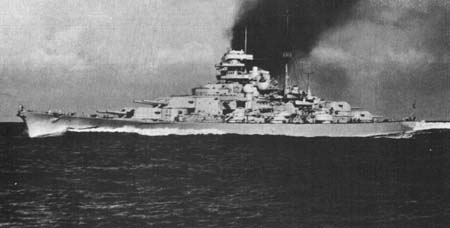 The Bismarck at high speed in the Baltic Sea. October 1940.
In Hamburg, the battleship was again moored to the Blohm & Voss equipping pier to receive the final adjustments. The 10.5-meter rangefinder on turret "Anton" was removed because its lack of utility due to sea water fogging at high speeds. The ship was also painted over with the striped camouflage used by most of the big German ships of that time. Three angled black and white stripes over the hull and superstructure, with the ship's ends in dark grey and false white waves. For aerial recognition, the national emblems (swastikas) were painted on the stern deck and breastworks, and dark grey was also applied to the top of the main and secondary batteries. The crews were released on Christmas leave, and for most of them this was to be the last chance to see their relatives. Lieutenant-Commander Adalbert Schneider acted as Bismarck’s Deputy Commander in substitution of Captain Lindemann from 16 to 31 December.On 24 January 1941, the Bismarck was again ready to go back to the Baltic to continue the sea trials, but the Kiel Canal was temporarily blocked by ice and the wreck of a merchant ship. Since the High Command disapproved the voyage around the Jutland Peninsula, the departure had to be postponed. Therefore, combat training in port continued through February until the canal was cleared.
The Bismarck at high speed in the Baltic Sea. October 1940.
In Hamburg, the battleship was again moored to the Blohm & Voss equipping pier to receive the final adjustments. The 10.5-meter rangefinder on turret "Anton" was removed because its lack of utility due to sea water fogging at high speeds. The ship was also painted over with the striped camouflage used by most of the big German ships of that time. Three angled black and white stripes over the hull and superstructure, with the ship's ends in dark grey and false white waves. For aerial recognition, the national emblems (swastikas) were painted on the stern deck and breastworks, and dark grey was also applied to the top of the main and secondary batteries. The crews were released on Christmas leave, and for most of them this was to be the last chance to see their relatives. Lieutenant-Commander Adalbert Schneider acted as Bismarck’s Deputy Commander in substitution of Captain Lindemann from 16 to 31 December.On 24 January 1941, the Bismarck was again ready to go back to the Baltic to continue the sea trials, but the Kiel Canal was temporarily blocked by ice and the wreck of a merchant ship. Since the High Command disapproved the voyage around the Jutland Peninsula, the departure had to be postponed. Therefore, combat training in port continued through February until the canal was cleared.
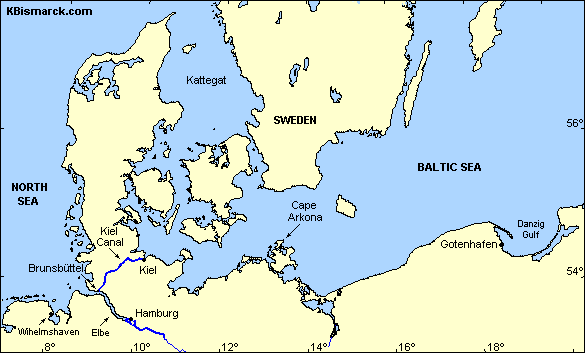 Finally, on 6 March the Bismarck departed Hamburg, steamed down the Elbe and anchored in Brunsbüttel Roads at 1224 hours, together with two blockade breakers (Sperrbrecher) and one icebreaker as protection against torpedo aircraft. At 0822 hours on the next day (7th) Bismarck weighed anchor and proceeded into Brunsbüttel locks aided by two bow tugs. Under the air cover of two Me-109 fighters she passed once again through the Kiel Canal. On 8 March, while approaching the Kiel-Holtenau sluice,Bismarck ran aground on the South side of the canal and had to be assisted by a tug, but she freed herself under her own engine power. Nevertheless, due to this incident, the ship went to Deutsche Werkein Kiel and was tied up inside Dock C where work on the under water hull and bottom painting was carried out. On 14 March, the Bismarck was undocked and was towed by tug to Scheerhafen, where the batteries were calibrated again, and the battleship loaded provisions, ammunition, fuel, and water. On 15 March, two Arado Ar 196 aircraft (T3+IH and T3+AK) were embarked; these were the first two aircraft of a total airwing of four that would arrive later. Two days later, on 17 March, the Bismarck left Kiel escorted by the old battleship Schlesien and the clearance vessel 36, and they steamed east to Gotenhafen.
Finally, on 6 March the Bismarck departed Hamburg, steamed down the Elbe and anchored in Brunsbüttel Roads at 1224 hours, together with two blockade breakers (Sperrbrecher) and one icebreaker as protection against torpedo aircraft. At 0822 hours on the next day (7th) Bismarck weighed anchor and proceeded into Brunsbüttel locks aided by two bow tugs. Under the air cover of two Me-109 fighters she passed once again through the Kiel Canal. On 8 March, while approaching the Kiel-Holtenau sluice,Bismarck ran aground on the South side of the canal and had to be assisted by a tug, but she freed herself under her own engine power. Nevertheless, due to this incident, the ship went to Deutsche Werkein Kiel and was tied up inside Dock C where work on the under water hull and bottom painting was carried out. On 14 March, the Bismarck was undocked and was towed by tug to Scheerhafen, where the batteries were calibrated again, and the battleship loaded provisions, ammunition, fuel, and water. On 15 March, two Arado Ar 196 aircraft (T3+IH and T3+AK) were embarked; these were the first two aircraft of a total airwing of four that would arrive later. Two days later, on 17 March, the Bismarck left Kiel escorted by the old battleship Schlesien and the clearance vessel 36, and they steamed east to Gotenhafen.

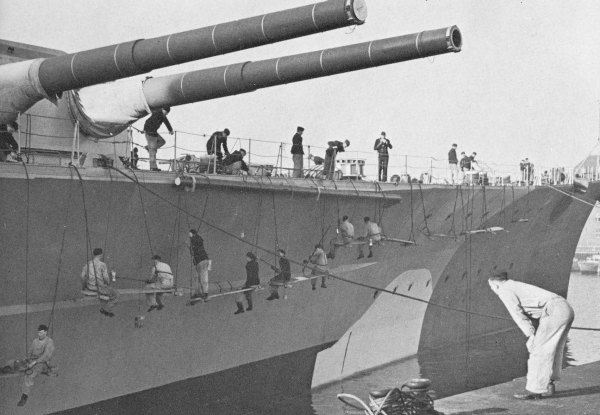 Hull painting and embarking of supplies in Scheerhafen, Kiel. 14-16 March 1941.
Hull painting and embarking of supplies in Scheerhafen, Kiel. 14-16 March 1941.
source : http://www.kbismarck.com/
















Không có nhận xét nào:
Đăng nhận xét